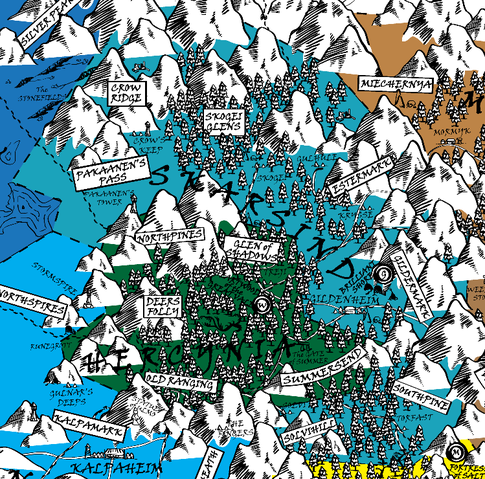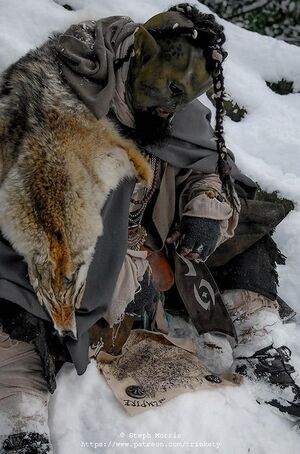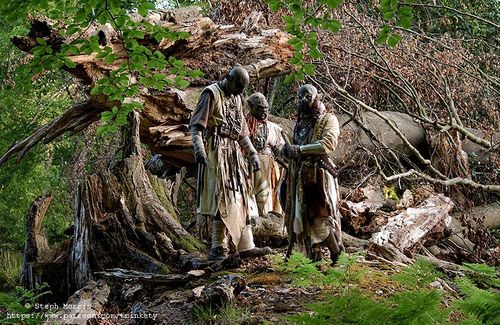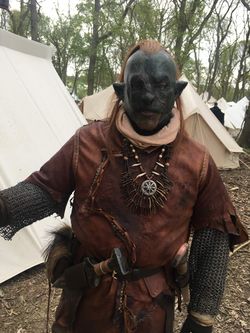Skarsind
Overview
Skarsind is a place of alpine slopes and valleys, pine forests and rising mists, set in what's known as the Great Vale, a bowl of mountains that holds both Skarsind and the forest of Hercynia. Summer is short, but Winter is long, and haunted by eerie lights in the sky. Gildenheim in the east was once the second largest settlement in Wintermark. The territory was once an important part of Wintermark; the folk of Skarsind were particularly noted for their fine rune work and many of the best artisans and runesmiths travelled here to study their craft.
Now, the people of Skarsind are the Imperial Orcs. There are still some Winterfolk here, but since the rise and fall of the Wintermark rebel Dogri Thulebane, the number of humans living in the hills and forests of Skarsind has tailed away to little more than a scattered handful. The Imperial Orcs do nothing to make them unwelcome, but for many there is simply nothing left for them in Skarsind. Regretfully in many cases, they leave to start new lives in Hahnmark, Kallavesa, and Sermersuaq.
The land has an ancient history - one that long predates the Empire or even humankind - and the remnants of older powers are everywhere. The largest settlement - Gildenheim - stands over the entrance to a frozen underworld cavern into the walls of which are carvings in a mysterious alphabet that are widely believed to be the source of the magical runes used throughout Wintermark. There are occasional troubles with yeti that live in the valleys above Skarsind, and the entire territory curves around the forests of Hercynia where an ancient vallorn still lurks. For many folk though the pressing danger remains the Thule that dwell on the far side of the mountains in Otkodov and who have long desired to possess this land.
Skarsind has always been riven by conflict; a saga called Lament for Skarsind is popular in some parts of Wintermark.
Recent History
In 373YE a savage blizzard swept down out of the mountains. The blizzard served as magical cover for an army of Thule barbarians who marched beneath it, using powerful Winter rituals to reinforce their armies with hordes of walking corpses created from battlefield dead. They attacked Gildenheim with the assistance of a dozen enslaved Artok, smashing great holes in the defences. Some small pockets of resistance remained - mostly based around the mines and halls to the north-east - but the situation looked increasingly desperate until 377YE, when Imperial forces were able to push into Skarsind and drive the Thule forces out of the territory and reclaim it for the Empire.
At the beginning of 379YE, the Wintermark people took the historic decision to bequeath the land to the Imperial Orcs. A motion was brought before the Imperial Senate to relinquish Skarsind so that it could be reassigned to the Imperial Orcs. The motion passed the Senate but could not be put into force without ratification by The Throne. This hurdle too was crossed when the Imperial Orcs acquired the Imperial favour of Empress Britta which granted the holder the ability to ratify a decision of the Imperial Senate. At that point Skarsind became an Imperial Orc territory.
The move was not without its critics however; not only would the Brilliant Shore cease to be a Wintermark Bourse seat, but the Winterfolk residents of Skarsind would almost certainly need to relocate to Hahnmark, Kallavesa, or Sermersuaq. There were even some Orcs who disagreed with the decision (perhaps unwilling to see the people of Skarsind made homeless on their behalf).
Many existing residents of the territory resisted the urge to give up their ancestral homeland. Their protest found leadership under the influence of a charismatic Thane, Dogri Thulebane, a Wintermark hero who had fought the Thule all his life. Dogri claimed the old, isolated fort of Crow's Keep in the north, an ideal position from which to watch both Otkodov and the Thule-dominated mountains of Silver Peaks in Sermersuaq. After a year of arguments, the Empire were forced to act on news that Dogri planned to raise an army to take the fight to the Thule in breach of the existing peace treaty. Shortly before the Spring Equinox 381YE the cruel Varushkan army, the Iron Helms, conquered Crows Keep and captured Dogri. The Thulebane was taken to Anvil where he was tried and ultimately executed. His death broke the spirit of those Wintermarkers who had hoped to hang on in Skarsind and most left soon after.
Not all is doom and gloom, however. Skarsind has seen a wave of rebuilding and improvements since the Imperial Orcs took custody in 379YE. New settlements and structures have been commissioned and constructed including the Legion's Rookery, the Red Blade Memorial, the Skarsind College of Warcasting, the new settlement at Whitelake, the Great Herd, the Halls of Worth overlooking Gildenheim, and even the peculiar Krampusshall near Pakaanan's Pass. The Northern trade network has been established, centred in the prosperous town of Torfast, while the valuable mineral wealth of the mountains and hills is harvested under the watchful eye of the Steward of the Mines of Gulhule. Skarsind has seen more development over the last few years than perhaps any other territory in the Empire.
Major Features
Gildenheim
At its height, Gildenheim was the second largest settlement in Wintermark. Founded by Gilda Heimssdottir, it stands over the entrance to a frozen underworld cavern into the walls of which are carvings in a mysterious alphabet that are said to be the source of the magical runes used throughout Wintermark and the wider Empire. It fell to the barbarians in 373YE after a long siege. Inge Suvvisdottir, most recent of the bearers of the crown of Wintermark, fell with it; the crown was lost when she fell and would not be recovered for many years. Despite the demands of Wintermark senators for resolute and overwhelming response, Emperor Walter dithered and did nothing to support the defence.
The Imperial Orcs have largely completed the work begun by the Winterfolk after the liberation, and the town again serves as a focal point for the territory. A number of civil servants are permanently posted here explicitly to help immigrant orcs settle into their new homes and emigrant Winterfolk to transition peacefully to the west, and there are extensive barracks and training grounds for use by the Imperial Orcs armies.
In the Autumn of 379YE, a Marcher by the name of Peter of Hintown discovered by chance what appears to be an ancient, collapsed Runeforge under Gildenheim. The ruins appear to hold particular interest for the Thule who have expressed an interest in purchasing the ruins from the Imperial Orcs. A historical research project was commissioned in Autumn 379YE to explore the so-called Gildenheim runeforge, revealing several intriguing mysteries. Ultimately, in 383YE, the remnants were painstakingly dismantled and transported to Runegrott in Hahnmark to be used as the basis for the creation of a new runeforge there.
The Ethengraw Black Forge stands in the hills near Gildenheim. The city is also home to significant numbers of Tamazi - much of the sept prefers the familiarity of a built-up area after generations in the citadels of Axos.
The walls of Gildenheim were reinforced and embellished with runic wards as part of a greater effort to fortify the city. Now, the walls serve as a fortification, with the cunning mithril wards of the Tamazi protecting against certain kinds of malign magic, such as Thunderous Tread of the Trees.
Legion's Rookery
One of the few structures left standing in Gildenheim after the Thule invasion was the Hall of the White Ravens. Many survivors saw this white granite hall as a symbol that Gildenheim could rise from the ashes, and reach even greater heights than before, but those dreams were abandoned when Skarsind was passed to the Imperial Orcs. In 381YE the Imperial Synod recognised the Doctrines of the Howling Abyss and the Ancestors which clarified and strengthened the place of those orc pilgrims who embraced the Way. As the implications of the changes to doctrine became clear, several well respected preachers called for a permanent site to serve as a focus for the faithful and to celebrate their newly defined status.
The Hall of White Ravens - by then the congregation of Cardinal Atla of the Assembly of the Way - was the obvious candidate to provide such a focus. The Hall was converted into the Legion's Rookery, a great hall that could serve as a spiritual centre for the Imperial Orcs to explore their understanding of The Way. Work on the Rookery was completed shortly before the Summer Solstice 381YE, taking advantage of the opportunity that presented itself to redesign and expanded the hall to serve as a school both to increase the understanding of the Way among the Imperial Orcs and as a place where new preachers could be trained.
As much as possible of the original structure was preserved - the worth of a building that had weathered two centuries and more without crumbling and even survived an occupation by the Thule was clear. Several of the white granite ravens that once adorned the front of the original structure were recovered and restored, and complemented by several new birds carved in an orcish style. The main structure is a great, simply decorated hall with a recessed fighting pit in the centre surrounded by several newer buildings, including a library for works relating to orc spirituality and one for housing items of worth related to the Imperial orc legions. One late addition is a subterranean chamber where no light is permitted - the chamber of the Abyss. Completely silent, profoundly dark and cold, some preachers meditate here to seek a greater understanding of the Howling Abyss - and some have reported that once all external distractions are removed it can sometimes be a little easier to hear the voices of the ancestors.
Following the Spring Equinox 386YE, the Legion's Rookery has been consecrated with true liao by Cardinal of Ambition Viviane Barossa de Coeurdefer of the League as the Imperial Synod recognised the ambition of Thrace. Following the consecration, the nation was inspired to build their nation, which came in remarkably useful with regards to their work to build homes in distant Mareave.
The Brilliant Shore
The Brilliant Shore is a Bourse resource located near Gildenheim. Custodianship of the Shore is an Imperial Title that brings with it a Seat on the Imperial Bourse. It produces 26 Imperial wains of white granite every season. Custodianship of the Brilliant Shore is an Imperial position. Control is allocated during the Summer Solstice.
Sorrowful Tunnels
During Spring 386YE, the Golden Pyramid Conclave order worked with the Imperial Orcs to explore opportunities to increase the prosperity of Skarsind. In the process they rediscovered the Sorrowful Tunnels. A group of prospectors, guided by Golden Pyramid dowsers found a network of unusually large tunnels and caves in the mountains of Gildermark. The "Sorrowful Tunnels" already had a poor reputation due to the dolorous aura that plagued anyone who tried to explore them. Causing powerful feelings of melancholy and sadness to descend on any who spent time in them, one that quickly becoming overpowering, meant that sensible people (both Winterfolk and Imperial Orcs) avoided the tunnels. A group of Varushkan miners from Volodmartz theorised that the aura might be an omen of something valuable hidden in the depths of the mountains, and were prepared to take the risk of delving deep into the darkness under Gildermark. Their tenacity was ultimately rewarded by the discovery that the old passages contained not one but two treasures.
The first was the discovery of runes carved into the walls of the tunnels suggesting that someone, or something, once dwelt here. All the signs pointed to a troll, or perhaps more than one, once having been in residence - perhaps even the creature that oversaw the Gildenheim runeforge. In addition to the archaeological significance of the Tunnels, however, the Varushkan miners quickly located rich seams of glistering mithril. More than enough to create a lucrative seat on the Imperial Bourse, once the immiserating aura that suffused the tunnels was dealt with.
During the Equinox, the Minister of Historical Research Vaclav Mladenovich Kosti, asked Snowstorm Henk of the Department of Historical Research to investigate the newly uncovered Tunnels. They eventually compiled and delivered a report, which was eventually published as Snowstorm Henk and the Sorrowful Tunnels.
The Will
The Will of the Wintermark is a fortification constructed in Skogei Glens to protect Skarsind from further Thule aggression. Built on a low hill surrounded by a fence of sharpened stakes, the sturdy walls of the Will of Wintermark are reinforced by white granite. The tall central keep is flanked by two shorter towers and topped with a great beacon to warn of invaders.
Work actually began on the castle during the campaign to drive the barbarians out, and was completed in early Autumn 378YE. The name is already being shortened to The Will in some places, and the local people have dubbed it Hengesthal or Hengest's House in praise of the Senator for Hahnmark who is widely regarded to have been the driving force behind the project. The Imperial Orcs who now garrison the fortification have adopted these names, and few people in Skarsind now refer to the castle as anything other than "The Will".
The Red Blade Memorial
The bonesetters of the Imperial Orcs have a lot of experience with desperate last-minute medicine on the battlefield, and know that they can never have enough herbs. In the past the Orc master physicks have been scattered across the Empire. Now they are together in one place, and working to adapt their strategies for cultivating herbs to the cold north. Yet there are many Orcs who will never see Skarsind. They died, often in battle, fighting for a homeland that they will never enter. Many have been laid to rest in far distant fields, the same fields they shed their blood to conquer or defend.
Taking inspiration from the Navarr, and their Memorial Gardens at Treji, a group of older bonesetters called the Fellowship of the Red Blade proposed that the Red Blade Memorial be built in Gildermark in memory of all those Imperial Orcs who will never see it. They volunteered to oversee and maintain the memorial - and share the lore they have gathered from the masters of herb lore across the Empire. This is not simply a memorial to the dead, but honours their names by spreading the healing arts of the chirurgeon, physick, and apothecary far and wide to help as many other prevent as many premature deaths as possible.
Krampushall (ruined)
Until its destruction by the Jotun following the Winter Solstice 383YE, the Krampushall stood in Pakaanan's Pass at the head of the Clattering Gulley. Technically an edifice, it was an impressive yet foreboding construction built during the Winter of 380YE, using materials from Wintermark and with permission of Irontide Vio the Imperial Orc senator. It was supposedly the permanent residence of the Krampus - the Wintermark spirit associated with their egregore, built on the request of that creature following some uncharacteristic behaviour over the course of the year 380. According to gossip, the plans were described by the Krampus itself, and it claimed that the site was the location of an identical building in pre-imperial times, which had subsequently fallen into ruin. The actual construction was carried out by Steinr runesmiths under the creature's direction. Some believed that the Krampus would accord some version of traditional Wintermark hospitality to visitors at its hall. Others warned that it was not wise to call in uninvited. It remains to be seen what its destruction portends for future relations with the peculiar wintertime spirit.
The Mountain Passes
Armies cannot pass freely through the mountains that surround Skarsind on three sides. There are only two passes large enough to permit free movement of troops between Skarsind and Sermersuaq, for example. The first - Crow's Path - is in the north, and connects Crow's Ridge with the Silver Peaks in Sermersuaq. Both regions are controlled by the Thule (and indeed, secured by Thule fortifications), so for an Imperial army to use the Path would require dealing with the northern orcs.
The second path through the mountains lay in the south, but following the Winter of 383YE a Jotun Yegarra force under the walrus banner of the human champion Eisa Winterborn sealed the western end of Pakaanan's Pass. Unless the Pass is cleared, it is unusable by Imperial armies. For the time being Imperial (and for that matter Jotun) armies cannot move directly between Sermersuaq and Skarsind without permission from the Thule.
In the north-east, the mountains also make it difficult for armies to move between Skarsind and Varushka, but here travel is significantly easier. The high peaks that overlook Estermark prevent armies moving through them into Miekarova (and vice versa). There is a single pass between the Skogei Glens and Miechernya, called Wulfric's Fall by the Winterfolk and Ustyma's Gate by the Varushkans. As of the treaty of Winter 383YE, the eastern end of the pass is controlled by the Thule. There is no such concern in the south - where the mountains are less vertiginous there are multiple routes between Gildermark and Southpine and Karov.
In the north there are two passes between Skarsind and Otkodov; both the Gate of Sorrows in Crow's Ridge and the Ice Road in Skogei Glens connect with the Thule region of Neeyukir in Urdur. The western pass is obviously controlled by the Thule; the eastern is under Imperial Orc control (at least the southern end is). These passes see a fair amount of caravans through the six months or so of the year that they are easy to traverse; from late Autumn to early Spring they are often blocked by heavy snowfall, avalanches, and in the Winter of 352YE, an actual wall of ice.
All of these strategic considerations are only a matter for large armies; smaller groups of soldiers can still use the less-accessible paths across the borders of Skarsind, such as White Lake which lies high in the mountains above Pakaanan's Pass.
Regions
Crow’s Ridge
- Qualities: Hills, Otkodov
The hills of Crow Ridge are desolate and cold. Following the ratification of the Summer 382YE peace treaty with the Thule, the region has been ceded to the orcs of Otkodov. Imperial orcs are still welcome to visit, but the region is very much in control of the Thule.
Passes allow travellers to go north to Otkodov, or west to the Silver Peaks, and with the establishment of the Northern trade network growing numbers of cautious Imperial merchants and Thule traders are passing through this region. High in the hills stands the craggy stronghold of Crow's Keep, a lookout tower and beacon built centuries ago by Wintermark siege engineers. Isolated, well-fortified, with a deep well and a single vertiginous approach, the keep weathered the Thule invasion and served as a base of operation for some of the Wintermark resistance. For a time after the Thule were defeated, Crow's Ridge was under the effective control of Dogri Thulebane and his Winterfolk supporters rather than the Imperial Orcs. The Iron Helms army arrested Dogri shortly after the Winter Solstice 380YE. Almost immediately after they took control, the Thule began rebuilding Crow's Keep into a full fortification to secure their presence here.
Estermark
- Qualities: Forest, Hills
The forested hills of Estermark are the site of two (formerly) wealthy settlements - Krysse and Gulhule. During the Thule occupation, Krysse became a bastion for the barbarians protecting their eastern flank. In happier days it had close ties with nearby Mormyk in the Varushkan territory of Miekarova and was a local centre of trade between the two nations, hosting a market at each turning of the seasons. With the liberation of Skarsind, the markets were restarted but one of the most prominent - the Four-Seasons Market - was destroyed in a catastrophic fire shortly after the Winter Solstice 380YE. A little less than a year later, the Weavers' Market was built on the ruins. Overseen by the Four Seasons' Boneweaver, thanks to a spelling mistake the market is shared by two very distinct groups of people - reavers with crystal mana to sell, and weavers trading in high quality clothing.
Gulhule is a valley settlement known for its runesmiths and well-crafted weaponry taken by the barbarians in 372YE. Empress Britta was instrumental in securing time for the people of Gulhule to escape the barbarian advance; many of the smiths escaped and founded forges elsewhere, scattered across the Halls of Wintermark. Others took refuge in mineworkings, such as the extensive Wells of Janon or the tunnels operated by the Crimson Peak miners. The black maggots of the Thule stripped the area and many captured Winterfolk runesmiths were taken as slaves by the barbarians.
Today Estermark has a growing population of Imperial Orc lumberjacks and forest owners. The Imperial Orcs traditional distaste for mining means that while the orcs are eager for the ore beneath the hills, they have little interest in digging it out themselves. Consequently the region has a surprisingly large population of human miners, based in several bustling mining camps, operating under the watchful eyes of the Foreman of the Mines of Gulhule.
Gildermark
- Quality: City, Ethengraw, Tamazi
This region is the site of the town of Gildenheim, once the primary Winterfolk settlement in Skarsind. The town has been largely rebuilt by the Imperial Orcs, and serves as an administrative centre - a number of civil servants are permanently posted here explicitly to help immigrant orcs settle into their new homes and emigrant Winterfolk to transition peacefully to the west.
One of the more fertile regions of Skarsind, Gildermark has also seen the establishment of new Imperial Orcs farmsteads and farming villages, and along with Solvihill and Southpine the region is one of the most populous in the new Orc homeland. The Ethengraw Black Forge was built near Gildermark, a series of massive smithies that provide the warrior sept with weapons and armour.
During the occupation, Gildermark was the central base of operation for the Thule. Their interest in the area was possibly fired by the presence of the Brilliant Shore (one of the largest quarries of white granite in the Empire) but their shamans and warlocks seemed fascinated by the icy caverns beneath the town. The region has been almost entirely denuded of trees - first by the Winterfolk, and then by the rapacious Thule.
Gildermark is also the site of Red Blade Memorial, which serves as a base of operations for the Fellowship of the Red Blade, a group of older bonesetters dedicated to spreading medical knowledge among, and preserving the lives of, Imperial Orcs. In the mountains overlooking Gildenheim, one also finds the Halls of Worth where Imperial Orc oathwrights explore their magical traditions, and offer aid to those seeking objects of worth.
The Sorrowful Tunnels are found in the mountains above Gildermark; a deep delve that predates the foundation of Wintermark which by all accounts was, or is, home to an ancient troll.
Pakaanan's Pass
- Quality: Hills
Pakaanan's Pass marks the easiest routes into northern Hahnmark and south-eastern Sermersuaq. Caravans once passed regularly in both directions, and with the rebuilding of Skarsind the passes are once again seeing merchants and traders keen to sell to their neighbours. This has done little to dispel the reputation for oddness that the hills here have, and settlements are scattered and generally built close to the roads and travellers are advised not to wander too far into the wilderness.
This reputation was only enhanced by the presence of Pakaanan's tower, an enigmatic tower of mammoth bone that was said to be impossible to enter. During the occupation, the Thule magicians made several apparently unsuccessful attempts to breach its walls. Given it allegedly contained the notes, paraphernalia and failed experiments of the legendary volhov, it is unsurprising attempts to get inside proved so popular. No-one ever managed to enter it - or discover why Pakaanan spent so much time here in virtual exile from the forests of Miekarova where he was born. At some point shortly after the liberation, however, the entire tower vanished leaving behind a circular garden of dark purple heather that flourishes to this day, yet never expands beyond the area that was once encircled by the tower's walls.
The Pass used to provide access through the mountains to Wintermark in the west. While the southern route to Hahnmark is still accessible, following the Winter of 383YE a Jotun Yegarra force under the walrus banner of the human champion Eisa Winterborn sealed the western end of the pass. Unless the Pass is cleared, it is unusable by Imperial armies. Smaller military units can still risk the higher and less accessible paths through the mountains, but for the time being Imperial (and for that matter Jotun) armies cannot move directly between Sermersuaq and Skarsind without permission from the Thule. The collapse also destroyed both the Clattering Gulley - a winding rock crevasse used for generations by Steinr Runesmiths to collect mana crystals - and the peculiar Krampushall that squatted balefully near the gulley.
Skogei Glens
- Quality: Forest
The forests of Skogei Glens are the site of the settlement of Skogei. This region was the last to be brought into Empire, in 154YE, and its halls were first to fall during the invasion of Skarsind. In 371YE its wooden walls were burnt, and few can now be found who once lived there. Recaptured by the Empire relatively early during the big push of 377YE, it was quickly reinforced with makeshift defences. In early Autumn 378YE, work was completed on The Will of the Wintermark, a solid fortification capable of defending the whole of Skarsind.
With the liberation of Skarsind, the Empire regained control of the Goeki Expanses, a large and previously very prosperous area rich in dragonbone. During Autumn 378YE, construction began on Sylvihrafn, a stone circle on the eastern border with Miekarova. Built near the Hold of Hrafnar, this magical site provides crystal mana to the Winterfolk Guardian of the Cairn each season.
Solvihill
- Qualities: Forest, Yerende
Forested Solvihill grows in prosperity as more Imperial Orcs settle here. Trade has invigorated the region - the Northern trade route from Kalapheim passes through Solvihill for example - and as one of the easiest to reach part of Skarsind it is also one of the most populous. The soil is not particularly rich here, but the forests are full of valuable hard and soft woods, herbs, and game animals. A number of new Imperial Orcs villages have begun to grow up scattered around the region, and the slow process of connecting them by roads has begun
During the occupation of the Thule the well-defended foresting town of Solvi served as a base of operations for the Imperial campaigns to drive the barbarians out. Once a foresting town providing Wintermark with wood, charcoal and beggarwood from the extensive barrens above the town, it was adopted as the base of campaign for the Imperial forces led by General Dunstan Irontongue. The settlement was hard pressed, and he led an aggressive series of sorties to relieve the pressure. He fell on one of these raids early in 376YE alongside Empress Britta. His body was never recovered.
A memorial to Dunstan, and to all those who fell alongside the Empress, is maintained by the orcs of the House of the Broken Shield, which stands near the outskirts of Solvi and serves as the home of a disparate band of orcs no longer physically able to fight the enemies of the Empire who serve in different ways.
This region holds the Palace of Flowers of the Yerende, built in early 385YE, and many of the sept still live in the vicinity.
Southpine
- Quality: Illarawm
There are forests here though they are not extensive, nor are there many hills, meaning Southpine is reasonably open - which is a rarity in the uneven terrain of Skarsind. Along with Solvihill and Gildermark, it is one of the most settled regions of Skarsind and has seen the establishment of many of the new Imperial Orcs family-run farmsteads that have begun to appear.
The settlement of Torfast, in the heart of Southpine, represented the high watermark of the barbarian advance in 373YE. It was retaken by Wintermark, League and Varushkan forces in 375YE, the first of the Skarsind settlements to be returned to the Empire. The town is now reasonably fortified, and bears the scars of many battles. It guards a major trade route from Skarsind’s forges down to the League city of Temeschwar, which helped caravans operated by businesses such as Southpine Southbound to get valuable supplies to the resistance forces throughout the occupation. It is also the heart of the Northern trade network, serving as a hub overseen by the Bonesetter of Torfast Trading Post.
The Ossuary temple of the Illarawm is found here, and many of the sept make their homes in the vicinity.
Special Qualities
- Part of Skarsind is controlled by the Thule rather than the Imperial Orcs
Crow's Ridge has the Otkodov quality because it is controlled by the Thule.
Strategic Considerations
In addition to the qualities of the individual regions, there are certain strategic consideration that affect military campaigns in Skarsind. The collapse of Pakaanan's Pass by the Jotun following the Winter Solstice 383YE prevents movement between Skarsind and East Floes. The only remaining pass large enough to allow a campaign army to move between Skarsind and Sermersuaq lies between Crow's Ridge and the Silver Peaks and both regions are controlled by the Thule orcs rather than the Empire. The other passes likewise control how armies can move between Skarsind and Varushka to the east, or Otkodov to the north.
| Summit | Elected |
|---|---|
| Winter Solstice 386YE | Bloodcrow Rasp |
| Winter Solstice 385YE | Bloodcrow Rasp |
| Winter Solstice 384YE | Bloodcrow Rasp |
| Autumn Equinox 384YE | Bloodcrow Rasp |
| Winter Solstice 383YE | Rurik |
| Winter Solstice 382YE | Rurik |
| Winter Solstice 381YE | Irontide Vio |
| Winter Solstice 380YE | Irontide Vio |
| Winter Solstice 379YE | Irontide Vio |
| Spring Equinox 379YE | Thanmir Hrafnar |
| Spring Equinox 378YE | Jorma Steelhail |
| Autumn Equinox 377YE | Triva of Tyrshalt |
Recent Senate Elections
As an Imperial territory, Skarsind is represented by a senator elected in the Winter. This title is currently held by Bloodcrow Rasp; it will be reelected at the next summit. The table to the right shows the citizens who have been elected to hold this title in the years since Empress Britta died.
OOC Notes
- Crow's Ridge has been ceded to the Thule. The remaining regions of Skarsind are in the hands of the Imperial Orcs (and by extension the Empire), making it an Imperial territory.
- The Ashen Tears Wayhouse in Skogei Glens allows Navarri characters to establish a personal resource in Skarsind and gain the benefit of any great work in the territory without suffering the penalty for having a resource in another nation.
- The Will is a level one fortification in Skogei Glens.
- The Walls of Gildenheim are a level one fortification in Gildermark that takes half casualties from magical attacks such as Thunderous Tread of the Trees.
- Congregations in the territory benefit from the Legion's Rookery and produce an extra 2 doses of liao each season.
- Herb gardens in the territory benefit from Red Blade Memorial and produce an extra 6 drams of true vervain each season.
- Following the conclusion of the Dogri Thulebane incident in 381YE, there is no remaining significant population of Winterfolk in Skarsind. There remain some player character halls, but they are isolated and exceptional, and characters can assume that their numbers will slowly dwindle. It is no longer possible for new players to start with their resources in Skarsind unless they are Imperial Orcs.
- A list of the spoils of war, allocated by the Military Council at the Winter Solstice 377YE can be found here.
Further Reading
Core Brief
Additional Information





